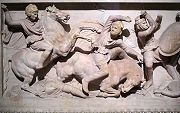According to pals at The New York Times, J. Ezra Merkin, the financier who lost billions of his investors’ money in the Bernard Madoff Ponzi scheme, has agreed to sell his famed collection of Mark Rothkos (plus some Giacomettis) for $310 million. The deal is expected to lead to a settlement of charges made by New York State Attorney General Andrew Cuomo. Here are the critical paragraphs in a breaking story:
According to people briefed on the matter, Mr. Merkin was paying as much as $60,000 a month for insurance and had $61.3 million left in loans originally taken out to buy the artwork, which was sold to an anonymous buyer.
The deal comes after weeks of negotiations between Mr. Merkin and Mr. Cuomo’s office over how the proceeds of the sale would be handled. The two sides eventually agreed to put about $191 million in an escrow that could eventually be used to repay investors. Justice Richard Lowe of the New York State Supreme Court is expected to approve the art deal.
And this:
“This will preserve assets that, if our litigation is successful, will provide restitution to victims of Mr. Merkin’s alleged fraud,” Mr. Cuomo’s office said in a statement.
Here’s the press release from Cuomo’s office.
In January, Ben Heller, 83, the art advisor who helped Merkin put together the collection, told Bloomberg News that “I am flooded with phone calls” from people who wanted to buy them.
Who could shell out $310 million in this climate? No one who knows talking. I did hear one person, however, conjecture that Pace Wildenstein, which sold some of the Rothkos to Merkin, may be the “buyer,” but one that has already lined up collectors to sell some works to.
Here’s the link to the NYTimes DealBook blog item.
Update: Bloomberg has now posted a story on the settlement, here.



